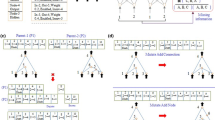Abstract
This study aimed at establishing a new computer-aided animation method using agent-based and physics modeling-based animation. The specific problem we addressed was to install adaptive behavior in a virtual creature placed in a complex environment, and to create its animated behavior automatically. The virtual creature is regarded as an autonomous agent who has sensors, actuators, and controllers. An artificial neural netword (ANN) and a central pattern generator (CPG) were adopted as the controllers. An optimization algorithm was introduced to train the controllers. Numerical experiments proved that the virtual creature acquires effective motions (walking, swimming) to move toward its destination, and to avoid obstacles and other creatures.
Similar content being viewed by others
Explore related subjects
Discover the latest articles, news and stories from top researchers in related subjects.References
Monaghan JJ (1992) Smoothed particle hydrodynamics. Annu Rev Astron Astrophys 30:543–574
Koshizuka S, Nobe A, Oka Y (1998) Numerical analysis of breaking waves using the moving particle semi-implicit method. Numerical Methods Fluids 26(7):751–769
NVIDIA PhysX (2011) http://www.nvidia.com/object/nvidia_physx.html
Matsuoka K (1985) Sustained oscillations generated by mutually inhibiting neurons with adaptation. Biol Cybern 52:367–376
Patel LN, Murray A, Hallam J (2005) Increased swimming control with evolved lamprey CPG controllers. Neural Networks IJCNN’ 05, 4:2195–2200
Author information
Authors and Affiliations
Corresponding author
Additional information
This work was presented in part at the 16th International Symposium on Artificial Life and Robotics, Oita, Japan, January 27–29, 2011
About this article
Cite this article
Iwadate, K., Suzuki, I., Yamamoto, M. et al. Behavior emergence of a virtual creature living in complex environments. Artif Life Robotics 16, 185–189 (2011). https://doi.org/10.1007/s10015-011-0905-0
Received:
Accepted:
Published:
Issue Date:
DOI: https://doi.org/10.1007/s10015-011-0905-0




